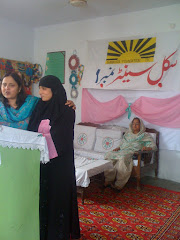


















CHOLISTAN DESERT

The word Cholistan is derived from the Turkish word Chol, which means Desert. Cholistan thus means Land of the Desert. The people of Cholistan lead a semi-nomadic life, moving from one place to another in search of water and fodder for their animals. The dry bed of the
The Desert also has an Annual Jeep Rally, known as Cholistan Desert Jeep Rally. It is the biggest motor sports event in
Culture and traditions
Local Dialect
The language of Cholistan also reflects a number of features of its historical and geographical background. The Saraiki language is an Indo-Aryan language of the Lahnda languages group, and is spoken in Cholistan as well as in a large part of central
Arts and crafts
In a harsh and barren land where rainfall is very sparse and unreliable, Cholistanis rely mainly on their livestock of sheep, goats, and camel. However in cold nights of winter they huddle indoor and engage themselves in various arts and crafts such as textiles, weaving, leatherwork, and pottery.
Local crafts
As mentioned above, the
Livestock
The backbone of Cholistan economy is cattle breeding. It has the major importance for satisfying the area's major needs for cottage industry as well as milk meat and fat. Because of the nomadic way of life the main wealth of the people are their cattle that are bred for sale, milked or shorn for their wool. Moreover, isolated as they were, they had to depend upon themselves for all their needs like food, clothing, and all the items of daily use. So all their crafts initially stemmed from necessity but later on they started exporting their goods to the other places as well. The estimated number of livestock in the desert areas is 1.6 million.
Cotton and wool products
Cholistan produces very superior type of carpet wool as compared to that produced in other parts of
Textiles
It may be mentioned that cotton textiles have always been a hallmark of craft of
Camel products
Camels are highly valued by the desert dwellers. Camels are not only useful for transportation and loading purposes, but its skin and wool are also quite worthwhile. Camel wool is spun and woven into beautiful woolen blankets known as falsies and into stylish and durable rugs. The camel's leather is also utilized in making kuppies, goblets, and expensive lampshades.
Leatherwork
Leatherwork is another important local cottage industry due to the large number of livestock here. Other than the products mentioned above, Khusa (shoes) is a specialty of this area. Cholistani khusas are very famous for the quality of workmanship, variety, and richness of designs especially when stitched and embroidered with golden or brightly colored threads.
Jewellery
The Cholistanis are fond of jewellery and have a craze for gold. The chief ornaments made and worn by them are Nath-nose gay, Katmala-necklace Kangan-bracelet, Pazeb- anklets, and Chandanhar etc., Gold and silver bangles are also made and worn with pride. The locals are experts in enamel works, and it is done on buttons of all sorts, earrings, bangles, and rings etc.
Love for colors
The great desert though considered to be colorless and drab, is not wholly devoid of color. Its green portion plays the role of "color belt" especially after rains when vegetation growth is at its peak. Adding to that the locals always wear brightly colored clothes mostly consisting of brilliant reds, blazing oranges shocking pinks, and startling yellows and greens. Even the cloth trappings of their bullocks and camels are richly colored and highly textured.
Terra Cotta
The Indus Civilization was the earliest center of ceramics, and thus the pottery of Cholistan has a long history. Local soil is very fine, thus most suitable for making pottery. The fineness of the earth can be observed on the Kacha houses which are actually plastered with mud but look like white cemented. The chief Cholistani ceramic articles are their surahies, piyalas, and glasses, remarkable for their lightness and fine finishing.
In the early times only the art of pottery and terracotta developed, but from the seventh century onwards, a large number of temples and images were also built on account of the intensified religious passions and the accumulation of wealth in cities. The building activity reached to such an extent that some cities actually became city temples. In fact the area particularly came to be known for its forts, villas, palaces, havelis, gateways, fortifications, and city walls.
































































































Great information about the culture and traditions of the Cholistan desert....
ReplyDeleteCheap Flights to Pakistan
If you want to find the best General Maintenance Company in Dubai
ReplyDelete, then contact Kabco Group.We have professional and specialized working staff.Find the most affordable and best services like as, HVAC, Plumbing, swimming pool maintenance, Electrical works, plumbing, and painting services.
Aetmaad is a leading real estate marketing company in Lahore, Pakistan. We provide you real estate opportunities to invest and gain lucrative gains. Buy, sell commercial and residential properties in Lahore with the help of our trusted and experienced real estate, marketing staff.
ReplyDeleteNice Post. The blog is really impressive and informative.Novel Concrete Pioneers in producing latest and innovative designs of floor and facing tiles in Lahore.
ReplyDeleteTuff Tiles price in pakistan